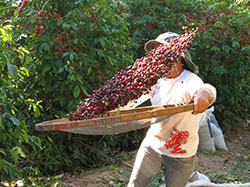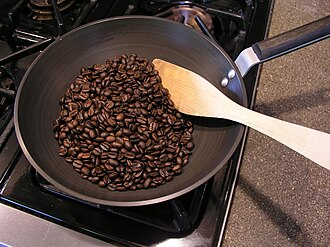- Home
- How to Roast Coffee at Home
How to Roast Coffee at Home
The topic of Roasting Coffee at Home is not simple or short, because there are so many options that people try, and a lot of comments that should be made about each method.
General Tips Applicable to All Methods:
Storing roasted beans:
When the beans are cool enough to touch, we suggest putting the beans in a freezer bag, squeezing all the air out, and sealing the bag. Never, ever, store them in the fridge or freezer. The temperature changes break down the coffee and create condensation inside the bag, and odors from the appliance will permeate your coffee. It actually shortens the life of the coffee unless you can store it at -10°F, which is much colder than your fridge freezer (which is usually 20°F). Coffee beans are not milk or lettuce. You cannot keep it fresher by putting it in the fridge.
If you have a home vacuum-sealer, yay! Vacuum-seal those puppies. They will outgas CO2 for some time afterwards, so expect the bag to puff up a lot in the next 2-3 days.
Resting your beans for the best flavor:
Contrary to popular myth, you generally don't want to grind and roast the beans immediately. While some coffees like our Brazil Cerrado seem not to need much rest and can be enjoyed right away, most coffees will be flat, woody, and bitter right after roasting.
Coffee is a polyphasic food, meaning many molecular changes occur after roasting. The beans need to outgas some of the products of combustion to achieve the right flavor balance. Most the time, you can enjoy the coffee the next day, although optimal rest periods can be 1 day, 2 days or even 3 days, depending on the coffee.
Short Overview of Methods
There are basically two types of roasting, "dry" and "wet".
Dry Roasting:
Almost all commercial roasters used in the USA are dry roasters that use hot air or radiated heat to roast the beans while they tumble around freely inside a drum or chamber.
Wet Roasting:
Popular in Asia, this is more of a stirring method in which oil and sometimes other ingredients are used.
Popular small home roasting methods and machines:
1. Pan or oven frying or roasting (usually with a little oil)
2. Corn-popper style hot air roasters (dry, air-driven)
3. Pot roasters with stirring blades (with oil)
4. Drum-style roasters that look like rotisseries (dry air)
Our Preferred Method
We’ve tried a lot of methods and for us, a small drum roaster has been the most versatile. It has its pros and cons, which we will get into, but what we like is that it is very safe and easy to use, provides consistent results, is adjustable/programmable, and gives a very even color to each and every bean. It's available from several retailers; Seattle Coffee Gear has a good rundown of its tech specs.

Behmor 1600 home drum roasterThe Behmor roasts coffee in about 15 minutes usually. You can adjust the temperature and time quite a bit, it is programmable. However, you can also just simply use it on the highest heat (P1) and watch and listen for the sounds of First Crack, and take it from there. The Behmor manual is fairly clear, so we will not reiterate it here. But for people considering a Behmor, here are some tips and comments:
You can roast up to a pound at a time, which is very high capacity for a roaster of this price range. However, you generally cannot get a dark roast when doing a pound. You will have to go to the longest cycle and highest temperature, and keep adding time, to try to get there. So, we recommend using a maximum of 10-12 ounces for a dark roast.
Wall current and other things turned on using the same current will slow down the roasting time. Try to plug the roaster right into a wall socket that does not have any other lights or appliances on at the same time.
The Behmor does supress some smoke, but don't expect it to get to a darker roast without smoke. Make sure you have good ventilation.
We suggest what they recommend, especially during cold weather: Turn the machine on for 30 seconds at P1 without the drum or chaff tray inside to help it warm up, then hit the off button (not Cool Down). Then load the beans in and hit the P button of choice to start the actual roast. This is like preheating the oven.
Never leave it unattended. You can do other things nearby for maybe 8 minutes as long as you can hear the cracking in case it starts. But after 8 minutes or so, you must actually sit and watch the machine. If you don't turn it off in time because you have walked away, it will start a big bonfire in the roaster which will bring the fire department and might ruin the roaster.
All this being said, we love our Behmor and use it for all our sample roasts, R&D, and whenever we want to try a new experimental roast level on a coffee.
Other Roasting Methods
We also see that hundreds of thousands of people across the USA use some other method, or even build their own gadgetry for the purpose. One hobby roaster we know built his own good-size barrel-style roaster to give him the volume he needed without sending thousands of dollars, which is what you would normally pay for any roaster that can do more than a couple of pounds at a time.
So we have provided some tips on most of the other gadgets and methods people have tried below. Some of these are methods people try once just to see if they like home roasting, and then they move on to something better.
Pan-frying beans
There was a time when homemakers in the USA could purchase only green, unroasted beans, and they would roast them at home, usually in a cast iron skillet or large cast iron pot with a stirring mechanism made for that purpose.. When pre-roasted beans finally hit the market around the 1930s, they were greeted with relief by people who had been pan-roasting beans because pan-roasting is very labor-intensive.
You cannot walk away from the beans, sorry.
Heat a heavy skillet to 350 F (medium heat) with green beans inside it, no more than will cover the bottom of the pan 1 to 1.5 beans deep. As the beans begin to get hot, you must stir them continually (think: making pudding... if you stop stirring, you won't like the result). Gradually increase the heat, stirring the beans to keep them evenly toasted. You should use a little oil; it helps keep the beans sliding around evenly and spreads the heat better. Just add a tablespoon of coconut oil, ghee, or other oil that is safe to use at high heat.
When the beans begin to turn medium brown, you will be waiting for them to make a popping sound, like pop corn does. This is called First Crack. After First Crack has finished (they might pop for 20 seconds to a minute), wait about 1 minute while stirring continuously... the beans will start to smoke. Take the beans off the heat. Do not wait for Second Crack, because you can't cool the beans quickly enough after second crack, and they will go dangerously close to bursting into flames before you can do anything about it. Fanning them increases the risk of fire. Do not wait for Second Crack.
Important: When pan-frying, you can't really get a very light or very dark roast. The beans are going to roast unevenly despite your best efforts, so you want to shoot for a medium roast for most consistent and pleasing taste. And shooting for dark roast may result in a fire in the pan, as coffee is VERY flammable!
After removing the beans from the heat, pour into a cool metal pan or bowl. (Never use plastic or any other material that may melt or crack from the sudden heat!) A large, wide pan or bowl works best, so the beans cool quickly and evenly. Spreading on a rimmed baking sheet is actually a good option. Fan the beans a little after they are off the stove, or stir them to get them to cool down as quickly as possible. A fast cool-down is desirable, taste-wise. Once they are started cooling, you can then walk away and let them just air-cool for ten minutes.
Oven roasting
Do not oven roast your beans. People attempt it, but it's impossible to bake the beans evenly, and if you keep opening the oven to stir them, you lose the heat. Seriously, it's just not a good idea. Certainly some people manage, but it comes under the heading of "Why on earth do this?"
If you bake them too much, you will start a fire. If you don't use high heat, you will dry the beans out and the flavor profile is flat.
Oven-baking coffee beans is sort of like trying to cook a duck with a candle. Either the candle will not be hot enough, or you will have to get the candle so close you will light the duck on fire. (We used "duck" for that statement because things with "k" in them sound funny.)
Stovetop Corn Popper

Fireplace popcorn poppers
make excellent coffee roasters.
Wise Men Trading offers a good
selection and tips on using them
for coffee roasting.
The cool thing about Whirly-Pop style roasting is that it does the same sort of thing that many bigger commercial (non-air) roasters actually do with coffee beans. There is a wide, deep pan, and a turn crank and two thin extensions on the bottom of the inside of the pan that spin around when you turn the crank. This type of roaster is ONY for wet-roasting, i.e. with oil instead of air.
In Asia they tend to use the "wet" process. They actually use butter and a little sugar to make a sort of brickle. The viscosity of the mixture aids the even turning over and over of the beans as they are stirred continuously. The advantage of this method is that it is fast and the beans have a different taste profile with the quick roasting time, and you can make genuine Vietnamese-style butter-roast coffee at home.
Quick recipe: Set the pan on medium high heat. Pour in 8 ounces of beans and a tablespoon of ghee. You can use coconut oil or other oil but it won't have the same caramelly, chocolatey taste. When you get near the end of the roasting time, as the beans brown up, add two tablespoons of sugar into the pot and mix it in quickly while turing the crank. When the beans begin to smoke you will hear some initial "cracks". Soon there will be more. There will be a fair amount of smoke when the beans reach medium roast level, so be sure you have ventilation. It's up to you to decide how dark to risk making the benas, but as always, we caution you that beans will BURST INTO FLAMES if you go too far.
If you love this sort of roast, you can add a teaspoon of cocoa, vanilla, or a little extract. Do not add these until the very end, just before you will finish cranking, so that the additions will definitely have time to coat the beans evenly but not enough time to burn or scorch the pan. Avoid putting anything in the pan that will stick to the aluminum and be hard to clean!
Open fire roasting
Fireplace popcorn poppers can be used to roast coffee on a campfire or fire pit. We guarantee that anybody who is accident-prone will probably burn their fingers or worse, so please use caution!
See the directions above for the stovetop popper... it is best to use 1-2 tablespoons of oil and put in beans (enough to cover the bottom 1-2 beans deep) before the pan is heated. Stir continuously, do not stop at all. After First Crack has been achieved, you can roast anywhere from 30 seconds (for Medium Roast) after the crack to the end of Second Crack (Dark Roast). Second Crack is a sound more like rice crispie cereal crackling when you pour milk on it, it's soft popping.
BEWARE: Soon after Second Crack comes Conflagration. The beans burst into flame and then afterwards, even the dog won't go near them. But the fire department may show up because your neighbor saw the billowing smoke pouring from your yard. So don't linger after Second Crack...
Microwaving beans
Seriously? Not a chance. Don't even think about it. For more information on THAT subject, just poll Google for "homemade bombs and house catastrophes".
Further Reading
We hope this has been helpful and informative for you. Once you're done here, we suggest moving on to some of our more specific pages on other topics related to getting the most out of your beans:
Latest Coffee Addition

Colombian Castillo Heritage Arabica!
Coffee from the days when Colombian coffee defined American consumer tastes. Warm, rich, delicious! Read more here!
 Loading... Please wait...
Loading... Please wait...



